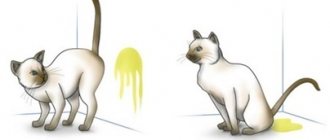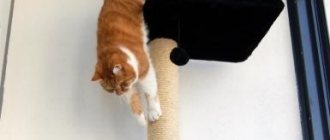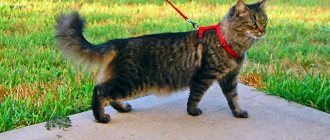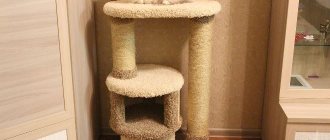6120Pavel
When keeping pets, there is often a need to perform certain procedures that require their immobility. If this is a cat, then he needs to trim his claws, get a haircut, perform medical procedures, for example, give injections. With all these procedures, it is important to know how to immobilize a cat correctly. After all, they are all stressful for the animal, which means it can behave completely unpredictably, injuring both itself and those around it.
To keep the cat from moving, it is not necessary to use sedatives or other tranquilizers; you can get by with another working method.
© shutterstock
How to clean a cat's face?
It is better to wipe the face with a damp sponge without using shampoo. Use special washing products, these are various shampoos for cats or kittens. Products for people, even children, are under no circumstances suitable, as they have inappropriate acidity (pH) and can irritate the animal’s skin.
Interesting materials:
What spices does carp like? What spices does salmon like? What canning methods are used to preserve food for the winter? What methods of cutting vegetables are used in cooking? What reference materials will be available on the exam in mathematics? What are the moon's satellites? What are the stages of alcoholism? What power supply standards exist? What are the VAT rates? What are the best steaks?
How to immobilize a cat: tips for beginners
To painlessly immobilize a cat, you need to use these tips::
- check the cat’s reaction to how you want to immobilize him;
- pre-wash your hands under clean water, possibly using non-scented soap, so as not to cause an unnecessary reaction from the cat;
- you can purchase special clips for cats, which are designed in accordance with the anatomical structure of the animal’s body;
- if both at the initial stages and during the process of immobilization the cat shows aggression, you should immediately abandon this method;
- no need to lift the cat by the scruff of the neck. If, nevertheless, the action is very important to perform, then it should be supported from below, for example, under the hind legs.
conclusions
- The clothespin allows you to secure the cat during nail trimming or veterinary procedures;
- The pet stops moving due to a reflex that allows cats to carry their babies;
- You can use any clothespin from five millimeters, but it’s better to use a special one bought at a pet store;
- You can restrain your cat both at home and at a groomer’s appointment or at a veterinary clinic;
- Not all cats are loyal to being fixed with a clothespin; check your reaction in advance.
When using materials from thebestvideo.ru, a link to the source is required.
Grooming
Despite the fact that the cat often licks itself, its fur requires additional care. For short-haired breeds, brushing is recommended weekly, and for those with thick and long hair - every day.
Read also: The mystery of the speed of dolphins
It is worth accustoming to this procedure as early as possible, this is the only way the combing will take place quickly and without problems. For shedding periods, combs with metal teeth are suitable. They are able to penetrate deep into the undercoat and remove loose hair.
Grooming with the help of a veterinarian
At home, cats often become, if not masters, then full members of the family. They perceive attempts to give medicine, trim claws or examine teeth negatively, running away, dodging or attacking the person. Similar behavior is observed when cutting hair. The animal hides in inaccessible places and attacks scissors or a machine.
Read also: Pumpkin jam with apples for the winter
In the veterinarian's office, your pet's behavior changes. Some are violent, but many resort to verbal resistance. That is, by continuing to howl and growl, the cat allows manipulations, such as injections and haircuts.
Hair styling is one of the services offered by animal clinics. It is quite expensive (comparable to minor, non-cavity surgery) and may involve anesthesia. The latter poses a risk to the life and health of the pet. On the Internet you can find reports of cats put into hibernation while their fur was being groomed, but which never woke up.
Anesthesia should be used only for medical or hygienic reasons. Thus, an animal with matted fur that does not allow the “armor” to be cut off will have to be put into medicinal sleep. If a cat that has moderated its aggression in the veterinarian’s office just needs to remove excess hair, you can negotiate with the doctor about the procedure for the price of an examination.
Safety precautions
You should not make the mistake of thinking that if a cat is very calm and docile in its normal state, then it will be just as calm when it is sick or in severe pain. The same can be said about taking especially nasty-tasting pills that can unbalance even a very calm animal. You should never put yourself at unnecessary risk by giving your pet medication without trying to hold it back. It's even worse when the cat is approached face-first without any restraint. We should not forget that cat bites and scratches are quite painful and can cause serious illness. Because of this, being safe is much better than being careless. If a cat scratches or bites its owner, then he should definitely consult a doctor.
Why does a cat freeze if there is a clothespin on its withers?
Cats freeze and stop resisting if you fix a clothespin on their withers. This is due to the instincts of the animal. Adult cats carry kittens in their teeth, just grabbing them by the withers. Nerve endings focused there cause the kitten to stop resisting and relax.
Consequently, the cat easily copes with carrying her baby. With age, the kitten's connection with its mother is lost, but its innate instincts are preserved. Therefore, a clothespin or anything that fixes the pet’s withers can lead to natural immobilization of the pet.
This method is often used during appointments with veterinarians or groomers. The fact is that some animals do not tolerate tranquilizers and sedatives well, exhibit allergic reactions or experience serious deterioration in health. But you can immobilize the animal by clamping it at the withers yourself, without medical assistance.
For example, when a pet needs to cut its nails or treat areas of skin affected by a dermatological disease. However, we must understand that any adult animal has its own unique temperament. So, without performing all the steps according to the algorithm, you may not achieve the desired result and may not fix the cat in one position.
Preparing a cat for immobilization
There is a really workable option to immobilize a cat with a clothespin or a paper clip - essentially the same thing. The item is attached to the withers without causing pain or discomfort for the cat. Behavior is inhibited spontaneously and reactions are slowed down. The cat will better tolerate this procedure, provided that it is performed by a person close to him, or better yet, by the owner. Also, manipulation should be carried out only in case of urgent need, and not for fun.
Most cats that were tried to be immobilized in this way experienced the action positively, without pain or fear. But no one is immune from the individual reaction of each individual cat.
First you need to prepare the cat for the procedure:
- If the pet is wearing a collar, it must be removed to provide free access to the cat's neck. If left on, it can create a suffocating feeling and your pet will become agitated.
- After this, you need to find the scruff. It is located on the outside of the cat's neck and looks like a loose fold. If it is difficult to feel the cat’s scruff, then it will not be easy to immobilize it. You should be extremely careful not to squeeze your cat's skin too hard.
- You need to grab the scruff of the neck with your hand and look at the pet’s reaction. If he feels completely relaxed, then he can quickly be immobilized. If the animal meows or tries to escape, then you need to try to immobilize it using another method.
You can determine that a cat is tense when he is not trying to escape by dilated pupils, intermittent breathing, and moving ears. If you grab it by the scruff of the neck closer to the ears, you can control the movement of the animal’s head. To avoid needing help when immobilizing a cat, it is better to watch a training video in advance. It's actually simple.
© shutterstock
Types of tranquilizers and their effects
In the previous section, we already said that sleeping pills are divided into three groups based on the duration of their effect. Let us describe these groups in more detail.
Short term
After taking them, the cat will sleep for 2-3 hours, most often used for transportation, with increased excitability, stress or sleep disorders.
The most effective drugs in this group:
- Xylanite . Available in the form of a solution for injection. Externally it appears as a colorless or light yellow liquid. Has a calming effect on small pets for 1.5 – 2 hours. It also acts as a pain reliever - in this case it acts for 15-30 minutes. The effect occurs on average after half an hour. Xlanit is administered intramuscularly to cats. The dosage is calculated at 0.15 ml per kg of animal weight.
- Intraval . Puts the cat to sleep for no longer than a quarter of an hour. In case of sleep disturbances, it increases its duration. Also used for convulsive seizures. It is introduced into the body intravenously.
- Barbamil . The drug is indicated for surgical interventions or severe stress. It is given to the cat orally. It is advisable to mix the medicine with a treat for the animal. Before use, consultation with a veterinarian is necessary, since the medicine has a number of contraindications.
Medium term
The animal goes to sleep for 4-5 hours. Prescribed for the treatment of serious mental disorders, severe seizures, and also for preparing a cat for sleep.
- Etaminal sodium . The drug is considered harmless to cats, non-toxic. Copes with nervous excitement and stress. The product is addictive, so it should be used with caution.
- Barbital sodium . The animal falls asleep 1.5 hours after administration. The drug is completely eliminated from the body after 10 hours.
- Chloral hydrate . The drug should not be taken by pregnant or lactating cats, as well as pets under six months of age. The drug has an even larger list of contraindications, so its use should begin after consultation with a veterinarian and under his constant supervision.
Long-term
The drugs induce the cat to sleep for 10 hours and are used only during surgical interventions. The drugs are available only by prescription and are used under the supervision of a veterinarian. When using, the dosage must be strictly observed, otherwise the animal may not wake up after sleeping pills.
- Ketamine . In addition to the main effect - a sleeping pill - the drug has an effect on the cardiovascular system: it stimulates the heart, increasing the heart rate and increasing blood pressure. It is administered intramuscularly and intravenously. The medicine should not be used for animals prone to seizures, as well as for procedures that can provoke seizures.
- Ftorotan . It is introduced into the animal's body by inhalation. It must be used with extreme caution, since the wrong dosage can lead to complete cardiac arrest. Anesthesia occurs quickly, without a phase of motor excitation. At the same time, the animal recovers from anesthesia just as quickly.
- Methoxyflurane. The drug is also administered by inhalation. The effect of the drug takes quite a long time, since its components are easily dissolved in lipids. It is used most often when not only a hypnotic effect is needed, but also an analgesic effect.
Important! Medium- and long-term groups of drugs can only be used for a short period, as they are highly addictive.
Sleeping pills are available in tablet form, but are extremely rare. Most often, the medicine is produced in the form of drops or liquid for the preparation of a solution for injection.
Attention! Drugs intended for humans are not suitable for animals, since the concentration of active substances in them is increased by 10-15 times.
Cat attack: what to do, how to fight
Contents hide
Cat attack: what to do, how to fight
Why did the author move the keyboard towards him and take up this article? The topic was suggested by a sad reader comment: “I used to love cats, but now I can’t stand them. The smell is all over the apartment, they howl, bite and scratch.” That's it, categorically. Why did our reader come to this idea? There must have been some negative experience. That's right: cats are more than just fluffy fur and a sweet song. Cats also have sharp teeth and claws!
Why do cats attack and rush? The author talked on this topic with many friends and colleagues - experts, behaviorists, and finally, breeders. One day an unexpected thesis was voiced. “Have you seen how lions attack? At least on TV? So, domestic cats attack for exactly the same reasons!” Suddenly!
The cat reacts to an external threat. “Are you going to hurt me? Get it!”
Territorial behavior. There is no need to unceremoniously invade the personal space of representatives of the cat family!
Threat of losing food. Historically, cats have struggled to survive every day to earn their daily bread. Opponents are not asleep - everyone wants to survive, even at the expense of the other. A domestic cat is also instinctively afraid of losing its food bowl!
Redirected aggression. Your indoor cat, while on the windowsill, saw his street relative walking around the yard in a boorish manner. The pet, of course, completely lacks the ability to drive away the insolent person. But he... attacks the owner - someone must be punished!
What does a cat's body language tell us? Mostly novice cat lovers fall for this bait and often miss warning signs. Cats almost never attack for no reason! We look: the ears are pressed down, the cat nervously beats its tail, purrs in low tones, hisses, and makes “big eyes.” Don't miss these signals, and you will be happy!
How to deal with this? Behaviorists (cat behavior specialists) believe that the attention of a mischievous cat needs to be redirected in time. Accordingly, distract the cat. Try something called play therapy! How this works is well shown in the children's cartoon “Ivashka from the Palace of Pioneers.” Kot-Bayun came to visit Baba Yaga. Smart Ivashka made a wind-up mouse and released it right in front of the “visitor”. He forgot why he came - he busied himself with the mouse. Be sure to keep this mouse with you! Moreover, progress has come a long way since then. Catch it - I don’t want to!
Another tip: retreat in time. Don’t get into trouble, don’t give events a chance to develop according to a negative scenario. Just get up and leave.
How to correct behavioral problems? As we noted above, cats do not attack just like that - only in strictly defined situations (depending on the specific animal). Be sure to systematize all such triggers (situations) for yourself. Respect the animal's personal space. Example: Many cats hate having their tummy touched. An awkward movement, and you are already covered in painful scratches. No need to get into trouble!
Try to diversify your pet's leisure time. Many “attacks” come from the most basic boredom! Cats are predators by nature, they need to maintain a “habitual” way of life - to climb, look out, throw down like a stone, grab the prey. What do you tell the purr to do when it is left to its own devices? All these cat towns, ladders, “fishing rods”, mice were invented for a reason, to extort money from the owners. Just during the day the cat gets busy, climbs, runs, jumps, watches. The owner simply doesn’t get to the point of scratching – there are so many interesting things to do all around!
What else? Try soothing sprays. Google it on the Internet - so-called homeopathic Bach drops help many people. According to the instructions, add a drop or two directly to a bowl of water.
Don't forget: sometimes cats show aggression as a response to fear and fear. Never bully your pets!
What to do when a cat attacks? Well, don't panic. Just try to determine the reason. Previously, the cat was calm and affectionate, but now how has it broken free? Start by going to the vet, you must first exclude purely medical aspects.
Did you get away with a scratch? This is perhaps the “easiest” option. Rinse the scratch thoroughly and treat with an antiseptic. In principle, this is enough - just try to keep the damaged area clean. When you receive a strong bite, the wound bleeds profusely - this is a cause for concern. First try to stop the bleeding. Then monitor the wound for the next 24 hours. There are no signs of healing, the wound continues to bleed - go to the nearest medical center. Please note that it is advisable to seek medical help immediately. Cat's claw disease can be serious.
As always, we look forward to your comments, dear readers. Share your stories, opinions, wishes. Who knows - maybe one of your comments will serve as a topic for another article!
Material used: How to Detect and Prevent a Cat Attack. Source: catster.com Photo: pixabay.com
An effective method to immobilize a cat
The process of immobilizing young healthy cats includes the following steps::
- Attaching a clip to the cat's scruff . You need to select a clothespin or clip approximately 5 cm in size and place the device on the withers directly behind the ears. Each owner can choose what exactly to pinch the scruff of the neck on their own. You need to look at the cat’s reaction to see what suits him best. If a paper clip puts too much pressure on the skin, the cat will not tolerate the pain.
- It is necessary to place the pet on its side . Since the cat relaxes too much after the clamp, he may involuntarily fall on his own. If this does not happen, you can gently press on the hind legs to remove resistance. You can tell that the cat is completely relaxed by his behavior. He tends to pull the lamps towards his muzzle, curls up into a ball, and places his tail between his paws. If the cat cannot be laid on its side, it continues to stubbornly stand on its feet and tucks its tail, which means it is not calm and is very scared.
- Using additional clothespins . The reception will help to completely relax the animal. To do this, several clamps must be placed a little further than the first one on the back of the neck along the spine. If the cat starts to get violent, then all the clamps need to be removed.
- Also, the method of placing a clothespin anywhere along the back along the spine may work for some cats, but greater effect can only be achieved when placed on the neck.
- After a few minutes, the clothespins need to be removed . However, the duration of the resulting peace of mind is sometimes completely unpredictable and is determined on an individual basis. Some cats are immobilized during the entire grooming and nail trimming procedure, while in other cases the animal can be deactivated for a short period of time.
Domestic cat
The situation when a domestic cat, everyone’s favorite, has fed kittens is quite common. The best option is timely sterilization of the cat. Unfortunately, not everyone can afford such a service, so we begin to rack our brains about what to do with its offspring. There are two options, and both of them are humane. The first is to make an agreement in advance at an animal shelter (and there are such in every city today), and then take the grown-up kittens there.
The second option is a little more troublesome, but very humane. After lambing, let the kittens grow up a little, photograph them to their advantage, and post the photo on social networks with the caption: “Fluffy pet is looking for caring owners.” This option works in 98% of cases. The remaining two percent then return to the first option.
There is another situation in which it is urgently necessary to get rid of a domestic cat (cat, kittens) - someone close to you has discovered an allergy to cat fur. This often happens when a baby is born and the cat has lived with you for quite a long time. There are a little more options here than in the first case. Firstly, you can give your pet to relatives, friends, and acquaintances. Secondly, social networks will come to the rescue again. Well, the third option is an animal shelter.
This terrible word "narcosis"
In fact, another term has long been used in medical practice - “anesthesia”. General anesthesia (anesthesia itself) is a state of deep sleep of an animal with complete loss of all sensitivity. Such anesthesia is necessary for serious painful operations; it saves the animal not only from suffering, but also from death due to painful shock.
There is also local anesthesia - this is a loss of sensitivity in certain areas of the body. Local anesthesia is divided into 8 types depending on where exactly the intervention should be performed.
Horrible stories about anesthesia will be passed on from mouth to mouth by more than one generation of pet owners. Let’s say right away (have the courage to bear this “news”) - there are no completely harmless anesthesia drugs. Nowhere.
However (here you can exhale) the harm of anesthesia is sometimes greatly exaggerated. Indeed, some drugs have a toxic effect on the liver and disrupt the functioning of the heart muscle. First of all, these are chloroform and phlorotane. The first one was banned for use a long time ago due to its high toxicity. The second is not used in veterinary medicine. All other drugs currently used do not have significant harmful effects on the liver and heart.
But still, the concept of anesthetic risk is not a myth. Under the influence of anesthesia, the heart rate accelerates or slows down, blood pressure decreases or increases (depending on the drugs used), body temperature decreases, metabolic processes slow down, and breathing becomes less frequent. All these changes can provoke the manifestation of various pathologies. For example, compensated heart failure, unnoticeable in an animal while awake, under anesthesia can complicate the functioning of the heart. In addition, an allergic reaction may occur to anesthetic drugs (like any other).
The older or, conversely, younger the animal, the higher the risk. Naturally, it also increases in sick, weakened animals. Therefore, as always and everywhere, everything depends on the qualifications of the doctor. Only he can assess the degree of risk, choose the appropriate drug, and carry out resuscitation measures, if necessary.
To finally reassure you, let's say that now the risk is, according to statistics, one death per more than a thousand operations.
Bathing and grooming bag
It is also called a bathing net, a bathing bag, or simply a cat swimsuit.
It is useful not only for water procedures, but also for other hygiene measures, as it allows you to partially immobilize the animal.
How to bathe a cat in such a bag
First you need to prepare for water procedures. Add shampoo to the container of water where you will wash the cat and whisk it until foamy. Then place the animal in the net and secure it with strings (laces), first on the neck, and then on the rest.
Material: 100% polyester. Size range – for small cats and kittens (S), for medium sizes (M), for large cats (L).
Well, let's look at the last clamp.











